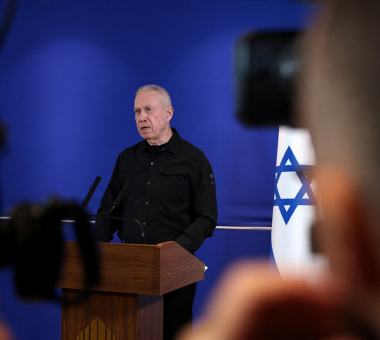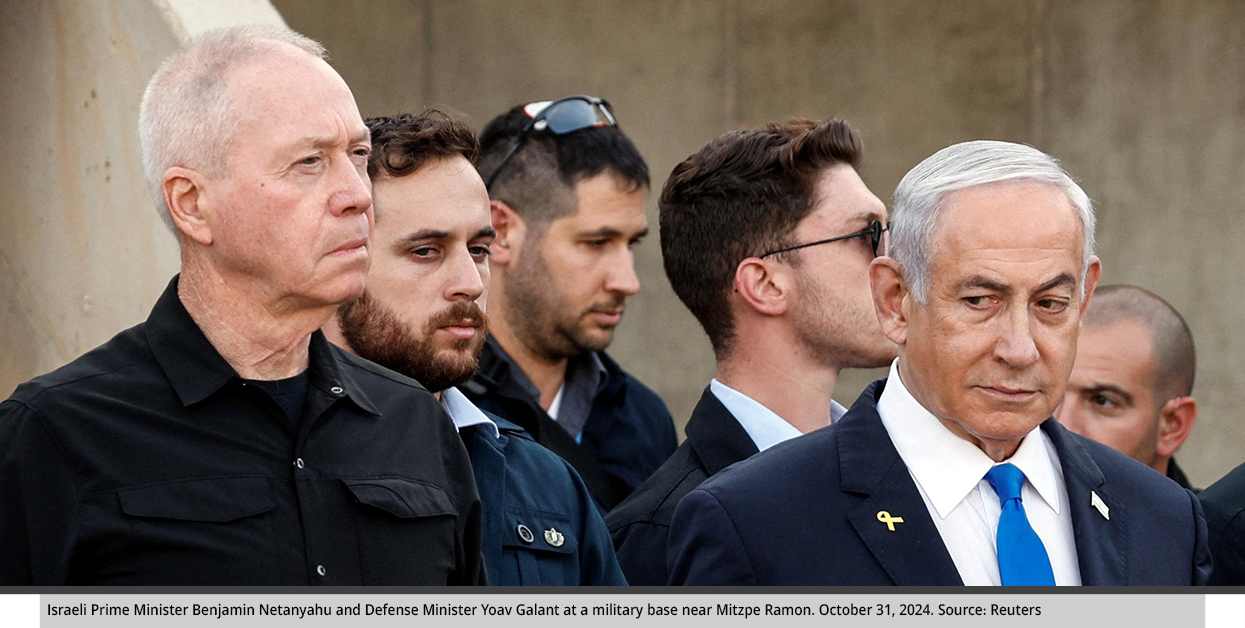How Gallant’s Dismissal Affects Israel’s War Management
The dismissal of Israeli Defense Minister Yoav Gallant came at a critical moment, coinciding with Election Day in the United States, the presumed end of the war in Gaza, the start of a new conflict in Lebanon, and a security leaks crisis that led to removing key officials from Prime Minister Benjamin Netanyahu’s office.
by STRATEGIECS Team
- Release Date – Nov 12, 2024

More than a year after the outbreak of the war on October 7, 2023, the Israeli government is undergoing rapid, and some say radical, changes in both personnel and direction. Triggering protests in the streets of Tel Avi, on November 5 Israeli Prime Minister Benjamin Netanyahu fired Defense Minister Yoav Gallant and appointed Foreign Minister Israel Katz as his replacement, while also appointing Gideon Sa’ar as the new foreign minister.
These moves are directly related to the course of the war in Gaza and Lebanon, and Israel’s objectives in those conflicts. At the same time, they bring the long-standing dispute between Netanyahu and Gallant back to its pre-war roots, with the significant difference being the timing of Gallant’s dismissal during a late stage of the war coinciding with Donald Trump’s return as the newly elected President of the United States.
Background and Root of the Disagreement
The developments in the wars in Gaza and Lebanon, coupled with the differing perspectives between Gallant and Benjamin Netanyahu regarding the priorities and objectives in each arena of conflict, led to the of their disagreements. Netanyahu justified Gallant’s dismissal by citing a “breakdown of trust” and “significant gaps” between them in managing the war, particularly in relation to Gallant’s statements and actions that sometimes conflicted with the decisions of the government and its security cabinet.
In contrast, Gallant attributed his dismissal to his pro-stance on the issue of compulsory military service for ultra-Orthodox Jews, his priority of securing the release of Israeli detainees held in Gaza, and his insistence on the establishment of a formal commission of inquiry into the failures of the Israeli security and military apparatuses on October 7, 2023.
Nevertheless, the disagreement over the management of the war was not new. The relationship between the two leaders had been fraught in recent months, and their crisis surfaced several times during the war before reaching its peak with Gallant’s dismissal. In mid-September, numerous reports and leaks indicated that Netanyahu was seriously considering dismissing Gallant and aligning with the leader of the right-wing National Unity Party, Gideon Sa’ar as a replacement. However, the prime minister backed down from this decision after the launch of ground operations in southern Lebanon at the beginning of October.
Even in the early months of the war, disagreements between the two were evident in various actions and on several occasions. Gallant, along with Benny Gantz, leader of the National Camp party and a member of the war cabinet before his June 9 resignation, refused to appear at press conferences alongside Netanyahu.

In fact, when looking at the history of the relationship between Gallant and Netanyahu, it quickly becomes apparent that it has been marked by multiple crises and challenges. Although Gallant left his former party, Kulanu, in 2019 to join Likud and shared Netanyahu’s views on supporting settlers and settlement expansion in the West Bank, there were other issues of disagreement as significant as the areas of agreement.
One of the main points of contention was Gallant’s opposition to the judicial reforms proposed by Netanyahu’s government that led to Netanyahu’s first attempt to dismiss Gallant from the Defense Ministry in late March 2023. Then, unlike today, Netanyahu backed down after facing fierce pressure from the Israeli public.
Another major issue of disagreement was Gallant’s stance on compulsory military service for ultra-Orthodox Jews (Haredim). Gallant firmly stated that “anyone of conscription age should serve in the army,” especially in light of the military’s need for recruits in the multi-front war. On the day of his dismissal, Gallant had issued 7,000 conscription orders for Haredim men qualified for military service.
The Importance of the Dismissal’s Timing
The timing of Gallant’s dismissal was critical: the presumed end of the war in the Gaza Strip, the beginning of another conflict in Lebanon, and the security leaks crisis in the prime minister’s office. In this context, the decision to fire Gallant was linked to political reasons, particularly by the Israeli opposition whose leader Yair Lapid accused Netanyahu of “selling Israel’s security and the lives of soldiers for his own political survival.” Benny Gantz, the prime minister’s political rival, described the dismissal as politically motivated and detrimental to Israel’s security, while in November former Prime Minister Ehud Olmert called for Netanyahu to resign because he is the one who started the war in Gaza. Additionally, there were calls from Knesset members for Israelis to protest the decision to fire Gallant.
Nonetheless, perhaps the most significant aspect of the timing of Gallant’s dismissal was its coincidence with the day of the U.S. elections. Assuming Trump would win the presidency, Netanyahu appointed Katz as Gallant’s replacement instead of Sa’ar, who had been the leading candidate in September to take over the Ministry of Defense. Katz has ties with Trump, having served as Israel’s Minister of Transportation and later as Foreign Minister (2019) during Trump’s first term (2017–2021). He was also part of the team involved in the recent peace agreements. In contrast, Gallant enjoys a close relationships with the administration of U.S. President Joe Biden. Gallant played a role in coordinating U.S.-Israeli positions, especially during times of crisis, but his connections with Biden were always a source of tension and mistrust between him and Netanyahu.

The dismissal of Gallant role in advancing the right-wing agenda related to the war
The victory of Trump in and the leadership changes in Israel align the theoretical and ideological perspectives between the two countries, particularly with regard to both sides preferring decisive action over conflict management. On one hand, during his first term, Trump sought to resolve the Palestinian issue by proposing what he called the “deal of the century” in 2020. His 181-page plan included recognizing Israeli settlements in the West Bank and Jerusalem as the capital of Israel (a recognition formally made on December 6, 2017) in exchange for Palestinians gaining a capital in parts of the occupied eastern suburbs of Jerusalem.
On the other hand, Gallant’s dismissal reflects broader implications, as it removes from Netanyahu’s inner circle a figure with deep military and security expertise necessary for astute decision-making. This change strengthens the role of far-right politicians eager to implement their agendas, particularly in the areas of military conscription laws, judicial reforms, and matters related to the wars in Gaza and Lebanon.
Figures like Katz and Sa’ar are more aligned with Netanyahu and the far-right ministers on issues related to the war, especially in post-war scenarios. Both support the complete eradication of Hamas and Hezbollah, as well as the return of Israeli settlements to the Gaza Strip—positions that contrast sharply with those of Gallant, who had consistently called for discussions on the post-war phase and its directions.
On May 5, Gallant publicly opposed the idea of Israeli post-war control over the Gaza Strip, and he showed openness to potentially conceding the Philadelphi Corridor in exchange for the return of Israeli detainees. Not unexpectedly, far-right ministers linked his dismissal to military progress in Gaza. National Security Minister Itamar Ben-Gvir declared “a complete victory cannot be achieved with him.” Communications Minister Shlomo Karhi said Gallant “did not rise to the level of heroism demonstrated by the Israeli army.” Heritage Minister Amihai Eliyahu even argued that Gallant’s dismissal would lead to better security in Gaza.
Finally, the Israeli government reshuffle and the return of Trump to the White House reinforce the far-right Israeli vision regarding the post-war phase. At the same time, it threatens the geography of both Palestine and Lebanon, especially as Israel is making geographic and demographic changes in the Gaza Strip, particularly in the northern areas of Jabalia and the Lebanese border villages with Israel.
With the weakening of both Hamas and Hezbollah, the year 2025 may see decisive actions regarding the situation in Lebanon and Gaza. This could include risks. One would be U.S. recognition of Israeli sovereignty over the Shebaa Farms, similar to Trump’s recognition of Israeli sovereignty over the Golan Heights on March 25, 2019. Another would be the legitimization of the buffer zones Israel is expanding in Gaza, as well as efforts to create such zones in southern Lebanon.
Regarding the escalation against Iran, it is likely that the factors restraining that escalation have weakened with the change in the U.S. presidency and Gallant’s dismissal. Netanyahu, who has been wanting to and working toward striking Iran’s nuclear facilities since 2010, elevated this agenda during the recent escalation despite the opposition he faced from the Biden administration and Israel’s security establishment. Consequently, the future of tensions between the two countries is now open to several scenarios, including potential alignment between Trump and Netanyahu on the need to neutralize Iran from regional issues and prevent it from developing nuclear weapons.

STRATEGIECS Team
Policy Analysis Team
 العربية
العربية